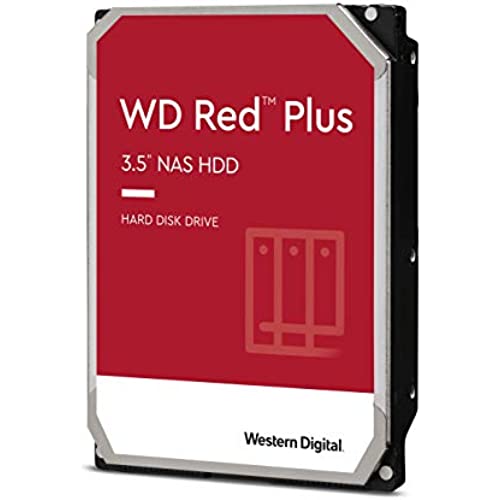
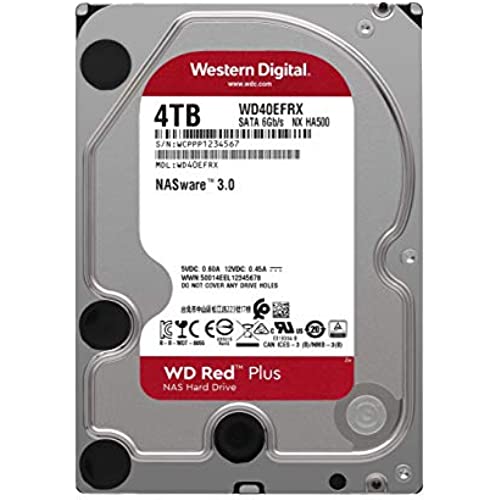
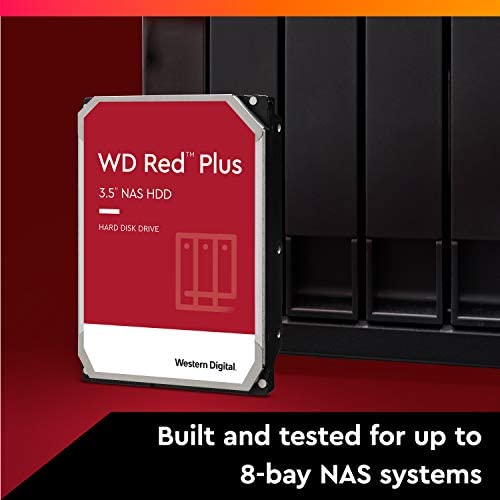
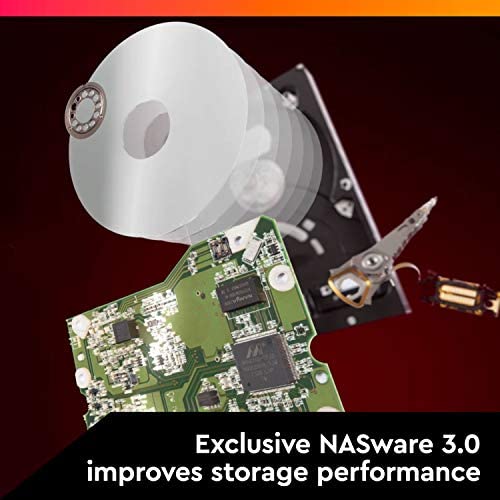

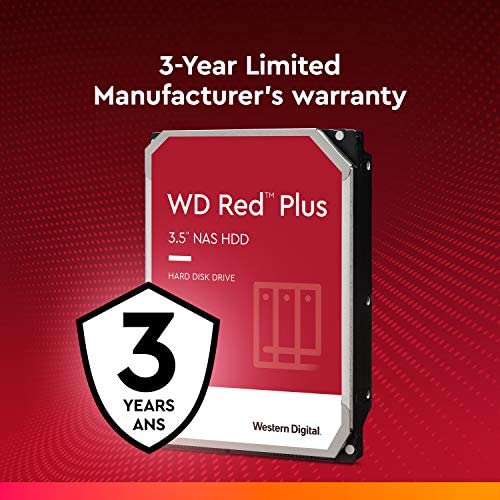
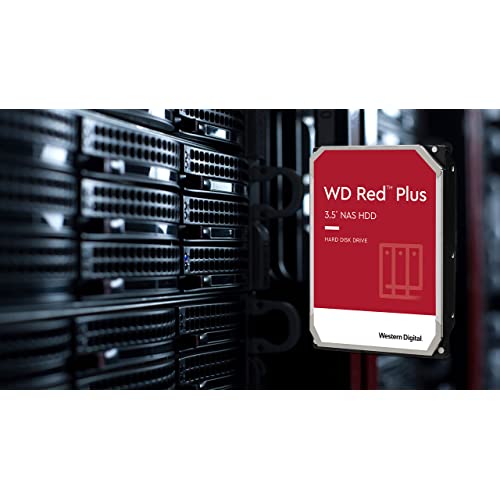







Western Digital 4TB WD Red Plus NAS Internal Hard Drive HDD - 5400 RPM, SATA 6 Gb/s, CMR, 64 MB Cache, 3.5 - WD40EFRX
-

CTBenko
> 24 hourGreat drives. Ive got 4x 4TB Reds in a custom server i made that has been running for 2+ years pretty much 24/7. Had to replace a failing Seagate drive (my fault using a standard Desktop HDD in a build like this) and these just work, and well. Build: CPU: ................Intel Core i5-4430 3.0GHz Quad-Core Processor Motherboard.......ASRock Z87E-ITX Mini ITX LGA1150 Motherboard Memory.............Kingston Blu 8GB (2 x 4GB) DDR3-1600 Memory Storage.............Crucial M500 120GB mSATA Solid State Disk Storage.............4x Western Digital Red 4TB 3.5 5900RPM Internal Hard Drive Case.................Fractal Design Node 304 Mini ITX Tower Case Power Supply.....Rosewill Capstone 450W 80+ Gold Certified ATX Power Supply Running Windows Server 2012 R2 Essentials and Pooled using Stablebit Drive Pool. I use it to serve up movies and TV shows via Plex, backup my other computers, and as a storage server. These Red drives work well as they are built for NAS usage and so they work well in situations where they are spun down frequently. I have considered the Seagate NAS drives too as they are sometimes cheaper but Ive had some issues with Seagate drives in the past (still use a 3TB one in my main desktop) and I have never in 20+ years had an issue with a WD drive. Others mileage may vary. For now and my needs 4x these are plenty of space with room to grow. Would be nice if they came out with 8+TB versions sometime soon though at an affordable price point. Seagate has had a 8TB drive out for a while and its generally cheaper than the 6TB Red, however im not sure how reliable the 8TB Seagate drive is.
-

Gary E. Peterson
> 24 hourHere is a quote from a review at pcper.com Im going to let the cat out of the bag right here and now. Everyones home RAID is likely an accident waiting to happen. If youre using regular consumer drives in a large array, there are some very simple (and likely) scenarios that can cause it to completely fail. Im guilty of operating under this same false hope - I have an 8-drive array of 3TB WD Caviar Greens in a RAID-5. For those uninitiated, RAID-5 is where one drive worth of capacity is volunteered for use as parity data, which is distributed amongst all drives in the array. This trick allows for no data loss in the case where a single drive fails. The RAID controller can simply figure out the missing data by running the extra parity through the same formula that created it. This is called redundancy, but I propose that its not. Since Im also guilty here with my huge array of Caviar Greens, let me also say that every few weeks I have a batch job that reads *all* data from that array. Why on earth would I need to occasionally and repeatedly read 21TB of data from something that should already be super reliable? Heres the failure scenario for what might happen to me if I didnt: * Array starts off operating as normal, but drive 3 has a bad sector that cropped up a few months back. This has gone unnoticed because the bad sector was part of a rarely accessed file. * During operation, drive 1 encounters a new bad sector. * Since drive 1 is a consumer drive it goes into a retry loop, repeatedly attempting to read and correct the bad sector. * The RAID controller exceeds its timeout threshold waiting on drive 1 and marks it offline. * Array is now in degraded status with drive 1 marked as failed. * User replaces drive 1. RAID controller initiates rebuild using parity data from the other drives. * During rebuild, RAID controller encounters the bad sector on drive 3. * Since drive 3 is a consumer drive it goes into a retry loop, repeatedly attempting to read and correct the bad sector. * The RAID controller exceeds its timeout threshold waiting on drive 3 and marks it offline. * Rebuild fails. At this point the way forward varies from controller to controller, but the long and short of it is that the data is at extreme risk of loss. There are ways to get it all back (most likely without that one bad sector on drive 3), but none of them are particularly easy. Now you may be asking yourself how enterprises run huge RAIDs and dont see this sort of problem? The answer is Time Limited Error Recovery - where the hard drive assumes it is part of an array, assumes there is redundancy, and is not afraid to quickly tell the host controller that it just cant complete the current I/O request. Heres how that scenario would have played out if the drives implemented some form of TLER: * Array starts off operating as normal, but drive 3 has developed a bad sector several weeks ago. This went unnoticed because the bad sector was part of a rarely accessed file. * During operation, drive 1 encounters a new bad sector. * Drive 1 makes a few read attempts and then reports a CRC error to the RAID controller. * The RAID controller maps out the bad sector, locating it elsewhere on the drive. The missing sector is rebuilt using parity data from the other drives in the array. *Array continues normal operation, with the error added to its event log. The above scenario is what would play out with an Areca RAID controller (Ive verified this personally). Other controllers may behave differently. A controller unable to do a bad sector remap might have just marked drive 1 as bad, but the key is that the rebuild would be much less likely to fail as drive 3 would not drop completely offline once the controller ran into the additional bad sector. The moral of this story is that typical consumer grade drives have data error timeouts that are far longer than the drive offline timeout of typical RAID controllers, and without some form of TLER, two bad sectors (totaling 1024 bytes) is all thats required to put multiple terabytes of data in grave danger. The Solution: The solution should be simple - just get some drives with TLER. The problem is that until now those were prohibitively expensive. Enterprise drives have all sorts of added features like accelerometers and pressure sensors to compensate for sliding in and out of a server rack while operating, as well as dealing with rapid pressure changes that take place when the server room door opens and the forced air circulation takes a quick detour. Those features just arent needed in that home NAS sitting on your bookshelf. What *is* needed is a WD Caviar Green that has TLER, and Western Digital delivers that in their new Red drives. End quote and back to reviewer. Ive got 5 of these in a
-

WBY
> 24 hourEarlier this year, I took a chance purchasing Seagates new 3TB HD for media storage and it died 2 months later. Since then Ive purchased a 3TB Western Digital RED drive (I would have picked the WD BLACK, but the price difference was a deal breaker). Its not in a NAS (just in PC), and with only one month in service I can say that at this point Im pleased with the drive and its performance. Its not as noisy, and certainly runs cooler than the dead Seagate, but time will tell. UPDATE: 10-14-12 I didnt wait for the six month period to bump it to 5-star status. I didnt mention it before but the dead Seagate was in a USB external housing which is what I put this in. I almost never hear it, and while I havent been as scientific as some (holding a stop watch, etc.)I have moved many large files to/from it, and then to two other external drives (same file each time) and the RED is by far the fastest, making things less time consuming. The others leave me toe-tapping or playing solitare until the transfers are complete. I bought a 2TB, not too long ago and plan to get 2 more 3TB drives before the end of the year. Yes, the RED series has a 3-year limited warranty. UPDATE: 11-17-12 The 3TB RED and my 3, 2TB REDs are still very happy campers, on a 24/7 basis. I recently built a PC for a customer and put the 1TB RED in it (about 3 weeks ago) and they are very happy with the build, and the first comment I received was Its so quiet. Our distributor tried to sway us from using these in anything other than a NAS, remarking that they were too slow, so I did some digging around various tech sites and came up with additional info: Due to its variable speed, Western Digital upped the MTBF from 650,000 hours to 1,000,000 3 year warranty with dedicated 24/7 support WD doesnt state the actual spin-speed, merely saying its Intellipower (meaning less than 7,200rpm), and from what Ive seen most put it in the 5400 to 5900 RPM range. The Drives cache memory was upgraded from DDR to DDR2 In a test pitting RED against other brand hard drives which run at 7200 RPM, it came out in the middle of the pack on random data tranfers, however, when transferring large media files (in the 20+ GB range) the RED beat the Seagate Barracuda by 2 minutes. UPDATE 12/31/12 No problems, runs cool, streams media great. The same goes for the 2- 2TB RED label drives in use. UPDATE 02/26/13 8 months of 24/7 and still going strong (3TB), 6 months of 24/7 and still going strong (2TB). So far, everyone Ive recommended these drives to (and bought them) are also Happy Campers. Update 06/28/2013 Nothing Good, Bad, or Ugly to add to my review. The system is up 24/7 in non-desirable conditions (76-80 degrees F, usually at 60%+humidity) and quality and reliability hasnt changed a bit! I cant recall but it has to be at least a year Ive been using the RED label.
-

uncle frank
> 24 hourCant go wrong with these drives if you have a home/small business NAS (1-8 drives). Purchased two 2-TB RED drives as used - very good from Amazon Warehouse Deals. These drives are specifically designed to function in NAS devices. Drives are to be installed in a QNAP TS-231 2-drive NAS - FYI please check the compatibility of your NAS device BEFORE you purchase drives for it. Most manufacturers have a list on their websites highly recommended to verif;y unless you buy a NAS with drives already installed. would leave five stars but not done with testing, even though I expect them to be great. Will revise once they are spinning for a while longer. WD sells RED drives in the following configurations: Model # Interface Form Factor Capacity Cache WD60EFRX SATA 6 Gb/s 3.5 Inch IntelliPower 6 TB 64 MB WD50EFRX SATA 6 Gb/s 3.5 Inch IntelliPower 5 TB 64 MB *WD40EFRX SATA 6 Gb/s 3.5 Inch IntelliPower 4 TB 64 MB *WD30EFRX SATA 6 Gb/s 3.5 Inch IntelliPower 3 TB 64 MB *WD20EFRX SATA 6 Gb/s 3.5 Inch IntelliPower 2 TB 64 MB *WD10EFRX SATA 6 Gb/s 3.5 Inch IntelliPower 1 TB 64 MB *WD10JFCX SATA 6 Gb/s 2.5 Inch IntelliPower 1 TB 16 MB *WD7500BFCX SATA 6 Gb/s 2.5 Inch IntelliPower 750 GB 16 MB •* Retailers may have existing product inventory of WD Red with NASware 2.0 for the specific capacities ranging from 1 TB – 4 TB. Please check with your retailer prior to purchasing for current inventory and product availability of WD Red with NASware 3.0 10-15- Update: Drives installed and running for about a week now. One drive was still in sealed bag and was new - the second one was run about 140 hours. All other S.M.A.R.T. data was perfect. Im not an advocate of used drives, but in this case, it seems to have worked out. Final note: WD makes a PRO version of this drive with a 5-year warranty, compared to three for this model.
-

GBelly
> 24 hourI purchased 2 of the 3TBs - put them in a Synology DS713+, ran SMART tests (checked out OK) and then put them to use. They were significantly quieter than the WD Black 2TBs I previously had in the Synology. Approx 7 days later the Synology notified me that the volume had failed. The quick SMART test said OK for both. I then ran the extended SMART test, with one of the drives hanging up at 90% for several hours. I removed the HDD in question and re-ran the extended SMART test in a Windows PC using Western Digitals diagnostic utility that I downloaded from their website. The HDD subsequently failed testing with a bunch of bad sectors. I received my replacement drive 1 day after initiating the return process (gotta love Amazon). I tested the replacement HDD in a PC before before installing it in the NAS. The new HDD was fine and has been in service with no issues to-date. Ive had many WD HDDs (mainly Blacks) over the years and this is the first one Ive had go south on me within the warranty period...so I suppose Ive been very lucky in that regard. My two takeaways from this: It really does appear to be the luck of the draw with these particular HDDs if you going to get a good one vs a DOA. When I think about the rough handling (being tossed into back of trucks, etc) these HDDs are subjected to during the shipping process, it actually surprises me that their fail rate isnt higher. The low bang for the buck with these Reds makes them a gamble Im prepared to take (I wouldnt be quite so open minded if Id spent the $$ on the SEs or REs and this was happening). From now on I plan on using the WD diagnostic utility to run extended SMART tests on any new drive before putting them into service. This is especially imperative for NAS drives - use the WD util in a Windows PC before installing them into the NAS (in my case it was far quicker & accurate to do this vs using the NAS to do the SMART test). Ive also scheduled weekly extended SMART tests in the Synology (once bitten, twice...) Lesson learned and Ill continue to be a WD customer.
-

Visualtang
> 24 hourI used this disk to replace a graphics and downloads drive on my home server. The old drive was a 1TB WD green from a few years ago. Since I figured I would give this drive a thorough run-through, I copied all the data using a USB 2 external adapter sitting on the floor on top of the bag the drive came in. It copied a few hundred thousand files of varying sizes in a couple of hours, mostly writing at about 31/MBs. I was surprised when it was running at how quiet the drive was and that it remained quite cool. After I pulled the old drive out of the server I compared the two, and this was actually lighter than the old 1TB green, I was surprised. In windows I ran a few crystal disk mark tests: The WD Red averaged 150 MB/s read and 130 MB/s write (Seq. 5 tests). The WD Green averaged 96 MB/s read and 88 MB/s write (Seq. 5 tests). Two Seagate 4TB drives (5900 RPM) in a Raid 1 averaged 143 MB/s read and 123 MB/s write (Seq. 5 tests). As the tests show, it outperformed the other drives, but the Seagates were definitely close and cost about 3/4 the price of the Red. I cant really speak for reliability since it has only been running a month, so my fingers are crossed for sure about that. My main problem with the huge storage drives available now is that it is pretty much mandatory to buy 2 in order to backup properly. You used to be able to get by backing up to tapes or discs, but its just not feasible with something like a 4TB drive. Heres hoping that this drive has Western Digital reliability and treats me as well as the old Green drive did.
-

Concretebrew
> 24 hourI have been around computers since the mid 80s and remember purchasing my first hard drive. It was for my Apple II in an enclosure about half the size of the computer with a self-contained power supply, fans and all sorts of what were then, goodies. It was an SCSI drive and it had a whopping 25 megabytes of space at my disposal. The hard drive was a Shugart, named after the fellow that built them and the predecessor of what is today, Seagate. There was a period of time in the 90s where my experiences with what were then the kingpins of hard drives, WD and Seagate simply did not prove reliable in a server or NAS environment which is why I always ended up paying top dollar for SCSI servers and enterprise drives that were significantly more expensive than an equivalent ATAPI desktop drive. When Samsung introduced their line of desktop drives, for the first time I felt comfortable using them in a server environment where they run 24/7. Today, after testing hard drives as they come out in both sizes and formats, I found that by far, WD has the best NAS drives for the money and they are not that much more expensive than a regular desktop drive. In fact, the WD Black line, which is intended for desktops is also a terrific drive and would not hesitate to stick them in a NAS box with one from their Red line. But I say so only from the point of view of reliability. As in the past I often found that anyone selling a non scuzzy drive claimed they were purpose built for a server environment, I questioned it as it seemed that I could not see any tangible evidence of them being anything more than the same drive as any other with a different label and a higher price. I can quantify the difference even between a WD Black drive and the Red NAS line. The transfer speeds are higher and they dont run nearly as hot which explains their great longevity under enterprise environment. There are still good reasons for going with enterprise scuzzy drives if that is what you need and can afford it. But for the everyday person that simply wants to keep their data backed up off site or off their PC, the WD Red line is a terrific drive and deliver a lot of bang for the buck. I presently have a location where I run 10 NAS boxes with two to four hard drives each and over time, the WD Red drives have outlasted Seagates equivalents -- by a long shot. That is not meant to be a put down of Seagate because I use their hybrid drives on my desktops and they are terrific. I personally prefer them to WDs Black line even though I know they are also great drives. I must admit that I am baffled when I read about someone these days getting, say, 4 new drives and one or two being DOA. Maybe Ive been fortunate, but I have purchased hundreds if not thousands of hard drives and I have yet to get one tha was DOA. Some clearly perform better than others and last longer than others, but as a whole, I would say the hard drive market is extremely mature and whether they are made in China or the US, makes no difference. All I can say is that in my experience and for my needs, the WD Red line is an excellent NAS drive and will continue to use them in the foreseeable future. Something else may come out that it is better or not. But when one is dealing with a NAS environment, there isnt much room for testing new equipment if the one I use now meets my needs and has proven itself. As my needs change, I will go through due diligence in determining what will be best. But at least presently, there are alternatives to SCSI if you do not need it and the prices per megabyte are lower than ever. I highly recommend this line of drives from WD for its intended use.
-

makoman50
> 24 hourI recently purchased four of these drives to make a new storage array in my workstation. I connected them in two pairs of Raid Mirror on a PCI controller board (with a backup controller) and then using windows to negotiate nightly backups between the two of them. Ive owned numerous western digital hard drives over the years and theyve hands-down been the most reliable. I was unsure about the Red Series of drives, however so far theyve been behaving well. Pros; Extremely high capacity-to-price ratio. Only exceeded by the Green series drives (which I would avoid due to performance issues) Sata 3 interface (not that this will saturate a sata channel, but its still nice) Large Cache 3 year Warranty Cons; I had been looking at using 2.5 drives due to heat, electricity and weight savings. WD doesnt make 2.5 drives anywhere near this large and they are prohibitively expensive per GB Theyre heavy. While normally not a huge consideration, for me it was, bear with me. It would be nice to have a 5 year warranty It would nice if they were fixed 7200 rpm drives, or at least if this was settable for those of us that want to keep out drives spinning all the time. Overall though; Unless you want to buy RE4 Enterprise level drives I would get these again. I will update this with any issues I have. NO MATTER WHAT THIS DOES NOT SUBSTITUTE A WELL THOUGHT OUT BACKUP SOLUTION. EVER. Seriously, go back your stuff up, RIGHT NOW.
-

Tonebalone
> 24 hourI bought 3 of these in October 2013 to use in a home server setting. They are configured in a RAID-5 array, and they have been running 24/7 for more than 9 years straight without a glitch. Im impressed.
-

Marine Corps Air
> 24 hourThese drives (10 in total) were purchased to complete the installation of two Digital Robotics (Drobo) 5N Network Attached Storage (NAS) devices. When I purchased my first Drobo 5N from Amazon several years ago the best Western Digital hard drive that was available was the EADS Green drives. However, technical support representatives from both Digital Robotics and Western Digital agreed that the EADS drives were not designed (or the correct) drive for NAS installations. Fortunately, subsequent to my initial purchase of five EADS drives Western Digital technology has continued to advance and the RED technology drives are now available. From the Western Digital website: http://www.wdc.com/en/products/products.aspx?id=810 NASware grows to 3.0 Built off of our determination to deliver the best NAS experience, NASware 3.0 extends our promise by further optimizing WD Red for the NAS environment with added support for 6 to 8 NAS bays. WD Red now supports small NAS systems from 1 to 8 bays thanks to NASware 3.0, which further improves drive compatibility and reliability. At 48 TB of total capacity in an 8 bay system, WD Red expands your NAS experience. and Professional solutions Designed specifically with SMB customers in mind, the WD Red family has expanded with the addition of WD Red Pro, which is available for the 8 to 16 bay medium to large-scale NAS environments. With capacities up to 4 TB, WD Red Pro carries a 5-year limited warranty and was engineered to handle the increased workloads from your business. A word of caution based on my actual experience. Regardless of the cost savings, purchase these drives directly from Amazon whose Customer Service is exceptional. I purchased another drive from one of the third party vendors. The vendor had listed it as a New drive. When I attempted to register it with WD I was informed that the three-year warranty had expired 18 months previously. The vendor had neglected to update the Amazon website and the drive itself, while still fresh on the vendor warehouse shelf, had been there for almost five years.
